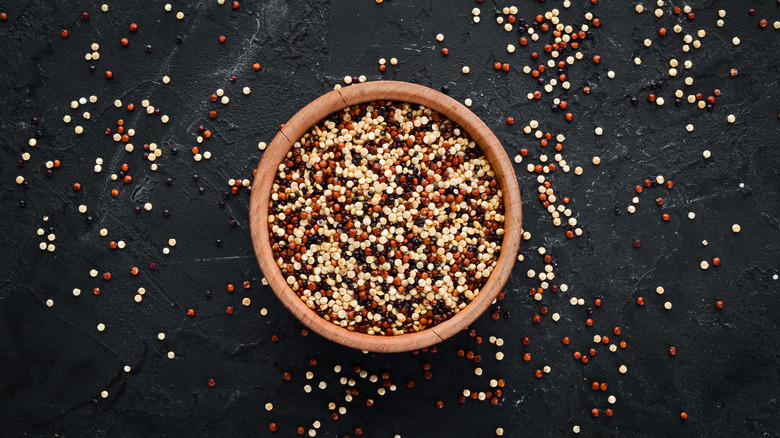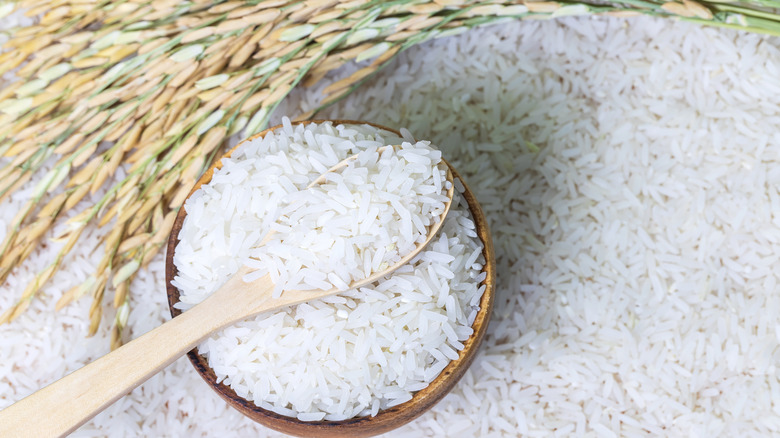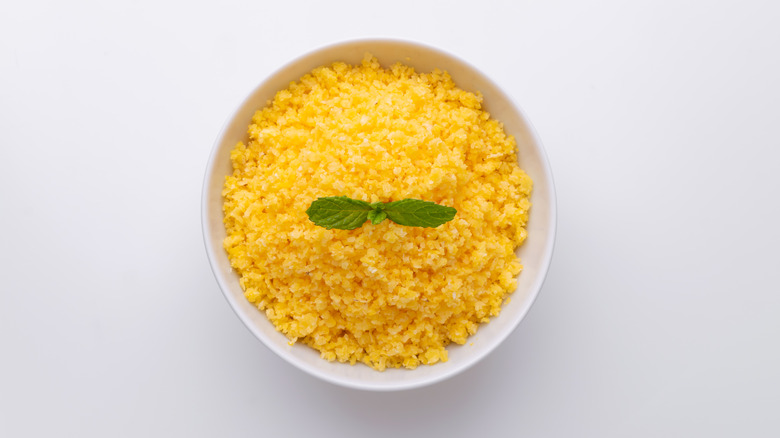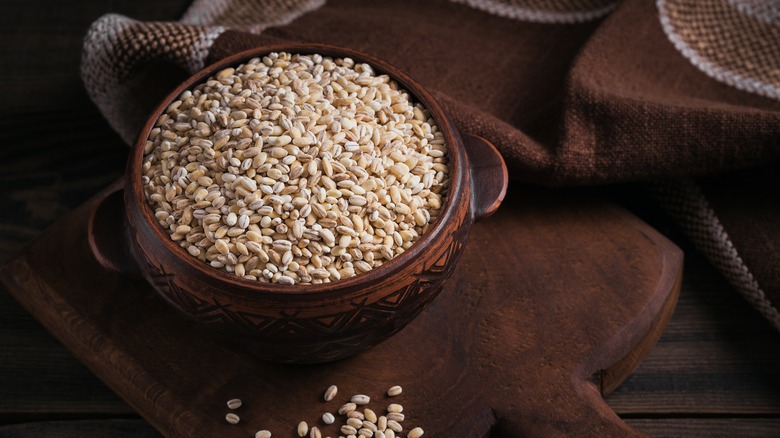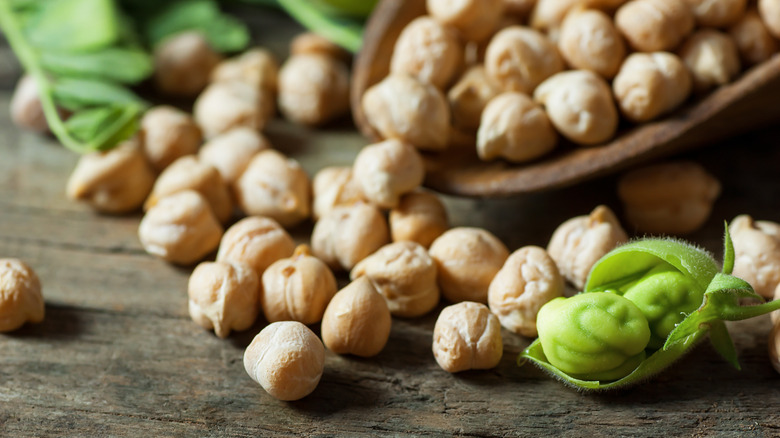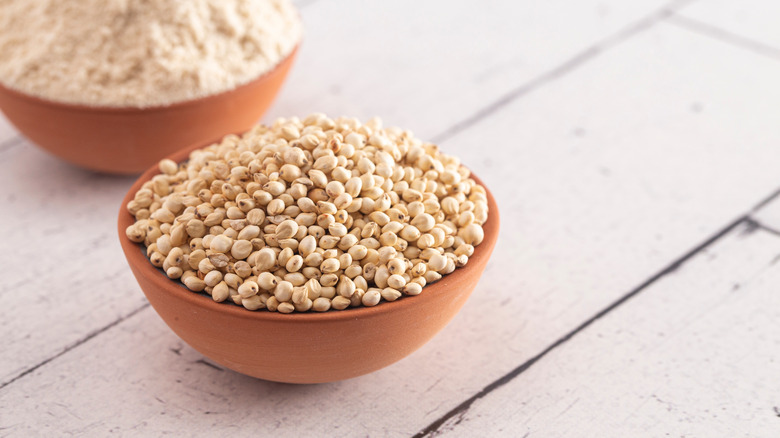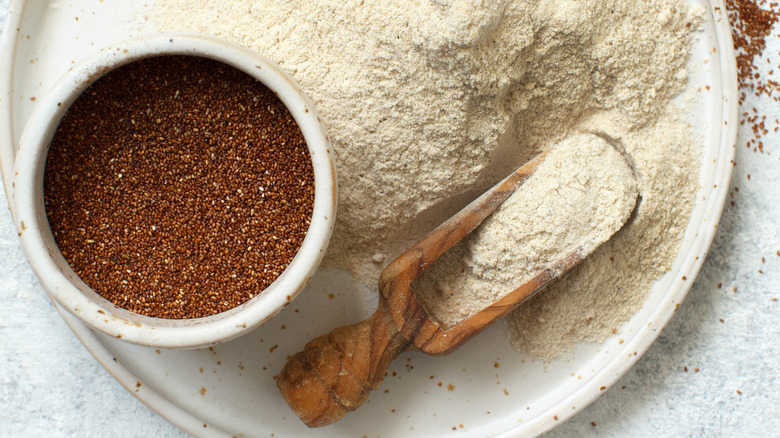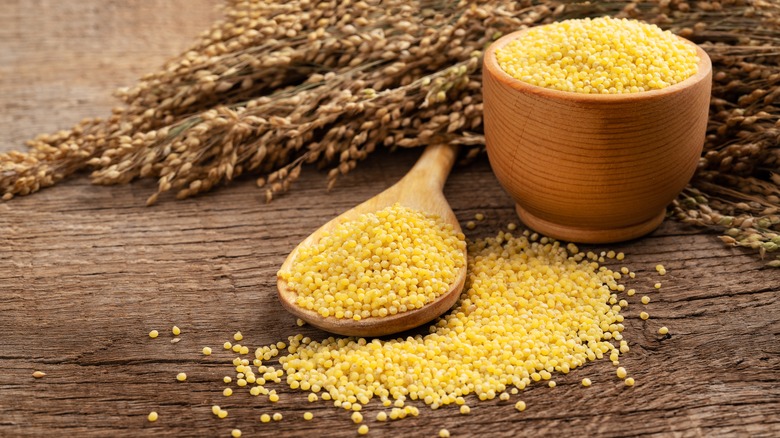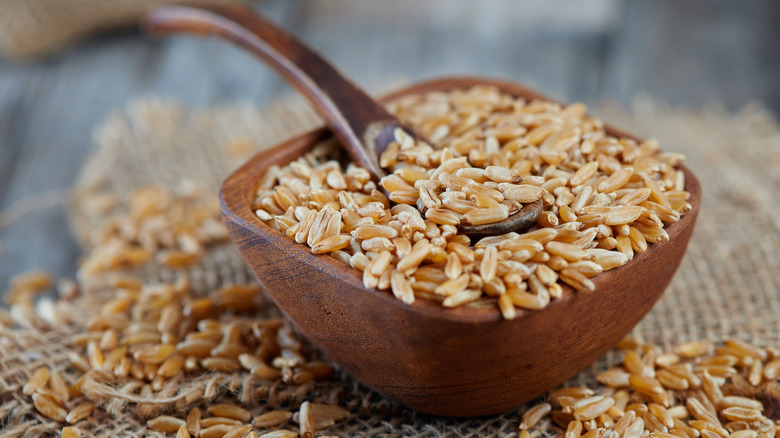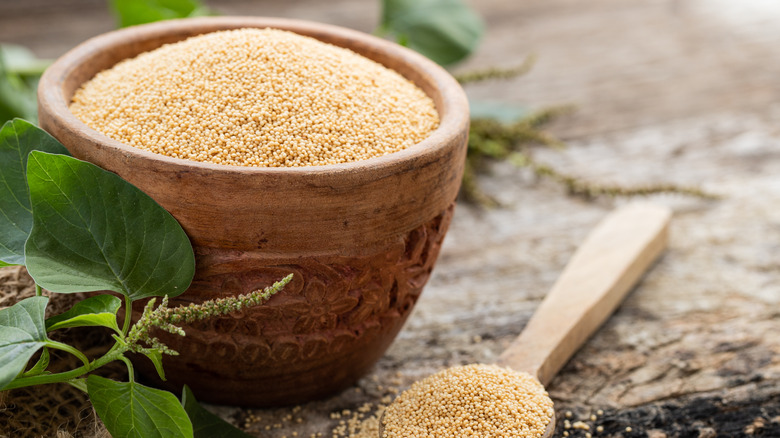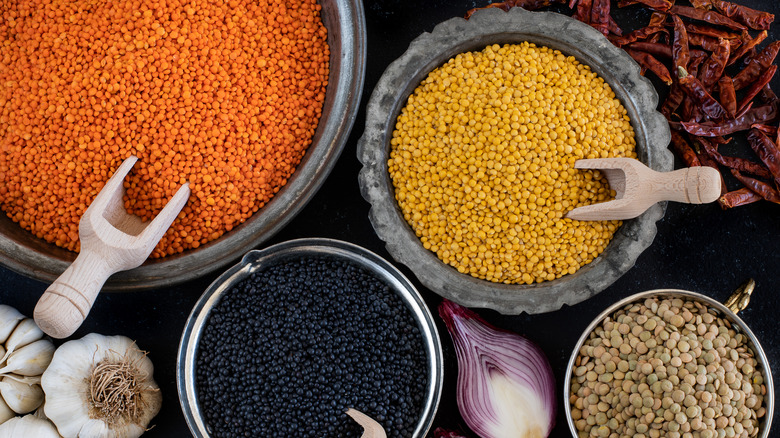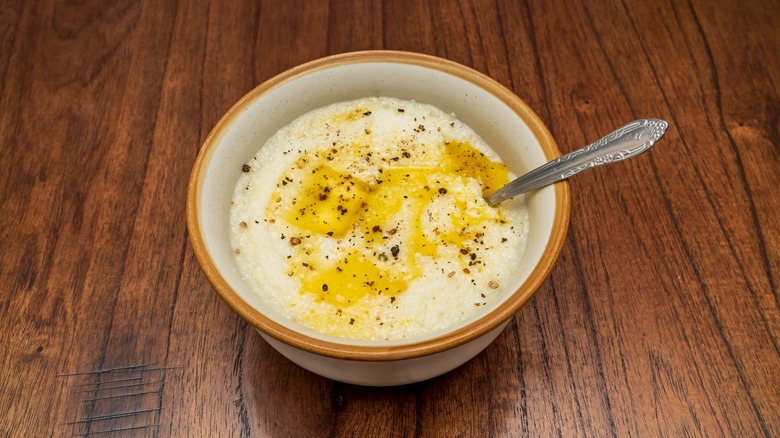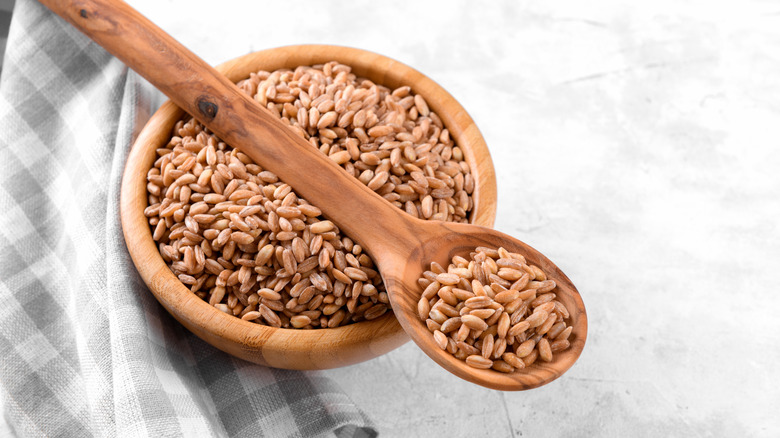12 Best Quinoa Substitutes
Quinoa hit the mainstream culinary world in the last decade, in part, as HuffPost reports, thanks to changing dietary trends, such as the rise of gluten-free diets and the growing popularity of "superfoods." However, while quinoa may seem relatively new — at least compared to staples like rice — this ancient grain is hardly up and coming. Instead, quinoa has graced plates for more than 5,000 years.
Originally grown in South America, quinoa is technically a seed, not a grain, and sits in the same family as beets and spinach. Whole, dried quinoa is cooked very similarly to rice in water or broth, expanding as it cooks and then fluffing up nicely to provide a healthy base and lending its nutty yet subdued flavor to more complex dishes like salads or casseroles. It can also be enjoyed plain as a side dish like you might eat rice or couscous. Luckily, given quinoa's versatility, it's easy to swap with other, similar grains as needed. Here are 12 other items you can substitute for quinoa in many recipes.
1. Rice
Yes, just saying you can use "rice" as a quinoa substitute is a bit vague. There are more than a dozen types of rice on any grocery store shelf and different types of rice come with their own properties. However, for most recipes that call for quinoa, your standard long-grain, jasmine, or brown rices work as suitable substitutes. Quinoa's nutty flavor is similar and both rice and quinoa make suitable backdrops for stronger, bolder flavors, whether you're putting together a Mexican-inspired side dish or a Mediterranean salad.
However, it is worth noting rice isn't quite as healthy as quinoa, if you're looking for a substitute with similar nutritional benefits. According to the University of Pittsburgh Medical Center, rice falls short when it comes to providing protein and amino acids, as well as micronutrients like iron and zinc. Quinoa is also lower in carbohydrates than rice. The two are similar, however, in both caloric and fiber content.
2. Couscous
Couscous is definitely similar to quinoa in that it also offers a nutty, fluffy blank canvas on which to paint your favorite flavors. However, couscous differs from quinoa in one key area. While quinoa is plant-derived and a seed, couscous is technically a pasta. It's made from durum wheat semolina, which means it's not gluten-free (via Beyond Celiac). Since quinoa is a popular pick for those following a gluten-free diet, this is worth noting in case the gluten is a worry for you, and you need a gluten-free quinoa substitute.
However, if you're not worried about the gluten, you can easily use couscous as a substitute in your favorite quinoa-based recipes. In fact, you may want to use couscous as a quinoa substitute even if you do have some quinoa in your pantry because it can be made with very little effort and time.
The best way to cook couscous is to heat your water to boiling, then pour your hot water over the couscous and cover it. The couscous will absorb the water and soften in as little as 10 minutes. It's then ready for fluffing and serving.
3. Barley
Barley is an ancient grain just like quinoa and a little more familiar to many home cooks, as one of the most popular grain crops in the world. While barley does have a very similar flavor profile to quinoa, it is more on the chewy side versus fluffy. Additionally, barley can be used in dishes that need a little bit of thickening.
Barley is more suited to recipes that require a longer cook time. It cooks much slower than quinoa, taking up to an hour versus the 20-ish minutes that quinoa will cook in. As such, barley is popular in soups or stews, so it could be a suitable quinoa substitute if you're making a quinoa-based soup.
Barley does contain gluten, so is not a suitable quinoa replacement for those looking to follow a gluten-free diet. Along those same lines, barley does not contain as much protein as quinoa, though it is a good source of minerals, essential acids, and vitamin B1.
4. Chickpeas
Chickpeas might seem a bit surprising as a substitute for quinoa, but, under the right circumstances and with the right recipes, chickpeas make a suitable swap. A member of the legume family, chickpeas are low in calories and packed with protein and nutrients. They're also gluten-free for anyone who prefers it.
Chickpeas are an excellent swap for quinoa. While chickpeas do have a unique texture, they're still on the softer side and have a nutty, mild flavor that makes them suitable as the base for salads or as a healthful, texture-enhancing addition to soups. However, chickpeas might be the best substitute for quinoa when you're specifically needing a substitute as fast as possible. Whereas quinoa requires cooking time, getting some chickpeas ready to add to a recipe is as easy as opening a can. Of course, you can use a dried variety in the same ways, but you should soak chickpeas before cooking.
5. Sorghum
You may know sorghum as a molasses-like sweet syrup that was popular in the South before spreading elsewhere. However, sorghum is much more than that sticky, viscous brown liquid you buy in a jar. In its original form, sorghum is an ancient grain, just like quinoa. This incredibly versatile grain can be cooked a variety of ways: popped like popcorn, baked as part of a granola, or even milled into flour for use in baked goods. However, if you're looking for a quinoa substitute, you'll want to cook sorghum similarly to how you might cook rice or quinoa — covered in hot water on the stove or, more easily, Instant Pot sorghum.
Sorghum works well in quinoa recipes that lean slightly more toward sweeter, warmer flavor profiles. Think of other ingredients like ginger, cinnamon, nutmeg, berries, or butter. It's especially a good fit in quinoa salads, where sorghum's chewier texture provides some variety.
6. Teff
When looking at quinoa substitutes, teff may be one of the lesser-known options. Teff is the seed of a plant that's a member of the grass family. While teff is generally more difficult to find and on the expensive side, it does come with some benefits. In addition to being gluten-free, teff is also a good source of fiber, protein, and B vitamins. In fact, it offers more fiber and more protein than quinoa, according to Lifestyle Asia. Teff cooks up just like brown rice in a three-to-one ratio of water to grain in boiling water for up to 30 minutes.
Teff's flavor profile has been described as nutty with darker hints of flavors like coffee and molasses. It's used in both sweet and savory recipes, but it might not be a good replacement for every single quinoa recipe in your arsenal. Popular for use in pilafs or stews, teff pairs well with spices such as cinnamon, ginger, and cardamom (via Maskal Teff).
7. Millet
Millet offers a flavor profile similar to quinoa but with an appearance and texture similar to couscous — just without the gluten content. Because of this, it's best used in recipes, such as salads or as a side dish, where you'd normally use quinoa for its small size and more basic flavor to complement bolder ingredients.
Just be careful when cooking millet: It's very easy to get the water ratio wrong, which will turn your millet into a gloopy mush more akin to grits or polenta than quinoa. If you want that creamer, denser texture, go ahead and cook the millet longer and with more water. However, if you want the best substitute for quinoa, use a two-to-one, water-to-millet ratio. Simmer the combination for about 20 minutes. With a little attention, the millet will come out fluffy, not clumpy. You can also make things easier on yourself by cooking your millet in an Instant Pot for less hovering over the stove.
8. Kamut
Kamut is a protein-rich pantry staple, which contains even more protein than quinoa. It can be used in place of other grains like rice in pilaf or casseroles thanks to its nutty flavor and firm texture. With 7.4 grams of fiber per cup and 9.8 grams of protein per cup, compared to quinoa's respective 5 grams of fiber and 8 grams of protein, it's especially a good swap if you're looking for the healthiest quinoa substitute possible.
Unfortunately, kamut is a wheat grain, so it does contain gluten, making it unsuitable for a gluten-free diet. It also doesn't make a good quinoa substitute if you're looking for a quick-cooking swap. Very Well Fit details that kamut needs to be boiled for up to an hour before serving. However, if you cook the grain in batches, you can store it and eat it cold, later, as part of a salad or other healthful dish.
9. Amaranth
Amaranth is very similar to quinoa. It's also an ancient grain with South American roots. It's technically a seed. It's gluten-free. It takes about the same amount of time to cook and cooks basically the same way. However, there are some big differences between amaranth and quinoa, which could impact whether or not you choose to use this particular substitute.
The biggest difference is the flavor. While quinoa is mild and makes a good base on which to build the larger overall flavor profile of a dish, amaranth is bold all on its own. Distinctive, sweet, nutty, and with a grassy aroma, amaranth isn't palatable to every diner, but if you can get past the grassy scent, you may just find you like amaranth as a swap for quinoa in bowls or as a side dish. Do note, however, that amaranth is higher than quinoa in calories, fat, and carbs, so it's not the most health-conscious swap.
10. Lentils
Compared to quinoa, lentils are a little more hearty and rib-sticking. They make an excellent swap for use in soups, stews, or salads where you might want a little more texture and heft. Like rice, there are different lentil varieties, including red, yellow, green, black, and brown. Each variety offers its own characteristics, but, generally, for salads, you'll want to go with green lentils. For dishes that require extra texture, you might want to go with brown lentils, and for soups and stews, you might want to pick red or yellow lentils.
As legumes, lentils have a very bean-y flavor and, if you don't like that, you're not going to like lentils on their own. However, if you're making a recipe that typically pairs quinoa with bigger, bolder, savory flavors, you'll find the lentils will adapt very nicely. Lentils offer a similar amount of fiber as quinoa at eight grams per cup.
11. Grits
Grits are a Southern favorite when paired with breakfast or served alongside seafood. But, if that's the only way you're enjoying this ingredient, you're sleeping on all of the possibilities grits provide. Grits are ground corn that varies in texture depending on the type you buy. Grits (unless they're instant) also take a little while longer to cook than quinoa, but the result is a creamy, thick, comfort food that pairs well with a variety of flavors. While grits aren't a good swap for quinoa that you might use in a salad or soup, grits can be used with very similar flavors if you're making a more simple quinoa side dish but find yourself fresh out.
After soaking grits overnight, the general rule is to cook them at a ratio of four parts liquid to one part grits. Easily as versatile as quinoa, and maybe even more so due to grits' even blander flavor, grits go best with strong ingredients that can hold their own — from cheese to capers to hot sauce.
12. Farro
Just like quinoa, farro is an ancient grain that's often used as a rice substitute. Farro does go by a few other names, such as einkorn, emmer, and spelt. Most of what you find on grocery store shelves is emmer. A little on the chewier side with a similar nutty flavor to quinoa, farro can be cooked two ways: like rice or like pasta.
If you cook your farro like rice, you'll want to let the grain absorb the water while it cooks. If you cook your farro like pasta, you'll want to boil it in a larger amount of salted water before draining and rinsing it, after you've achieved your desired texture.
While farro is called an ancient grain, it does contain wheat, according to Beyond Celiac, so it's not a good gluten-free quinoa substitute. However, if that's not an issue for you, you can use farro in any quinoa recipe that takes advantage of quinoa's nutty, milder flavor and where you want a slightly chewy texture, such as in salads or side dishes.
